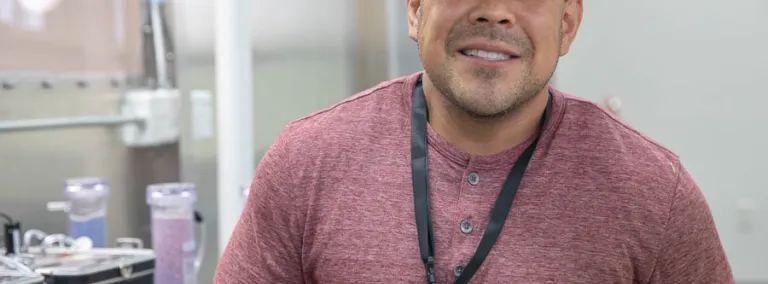Building a ship in a bottle
Derek Lucero joins LZ team as it begins assembly in preparation to move underground
When a project involves more than 200 scientists from 36 institutions around the world who are building a hypersensitive experiment, there must be a strong team behind the construction and maintenance of the structures that support these experiments. And Derek Lucero, who has worked as an infrastructure technician at the Sanford Underground Research Facility since 2010, is lending his hand to this cause. In May, Lucero became the Engineering Technician for LUX-ZEPLIN (LZ), a second-generation dark matter detector that will be located at the 4850 Level.
Lucero began his career at Sanford Lab working in both the Ross and Yates shafts, but soon joined a team solely dedicated to the Ross Shaft Rehabilitation Project. The project is replacing the inner framework of the entire 5,000-foot Ross Shaft—from top to bottom—to better suit the needs of science.
“It’s never been done before in the world, which meant there was a lot of problem solving,” Lucero said. “Both the engineers and the work force had to figure it out and make adjustments.”
For the past five years, the team has been cutting out the old steel, adding ground support and installing new steel. Lucero was the lead infrastructure technician for one crew.
For over six years, Lucero has also contributed to the safety of the SURF environment through his long-standing presence on the Emergency Response Team. He is trained to address inherent underground and laboratory working hazards, as well as best emergency response practices.
“He’s knowledgeable and engaged in the training we do,” said Paul “Woody” Hover, emergency response team lead and site safety specialist. “His work is outstanding, and I’m very glad he’s on the team.”
Lucero will continue to be involved with ERT as he transfers from shafts man to his new position as Engineering Technician with the leading-edge LZ experiment.
The LZ detector will replace the Large Underground Xenon (LUX) experiment and is on track to begin its deep-underground hunt for theoretical particles known as WIMPs—weakly interacting massive particles—in 2020.
The design process for the LZ detector and its supporting systems has been a collaborative effort spanning several years. The engineering department at SURF coordinated the various design elements, fitting pieces together in a way that will best facilitate underground science.
“Before we get to the science of LZ, first we have to build it—that’s going to take several years,” said Simon Fiorucci, a physicist at Lawrence Berkeley National Lab who oversees operations for LZ. “In order to assemble the many parts of the detector, we need hands—hands that know what they are doing. We’ve hired people who are here the whole time to do the bulk of this. Derek will be doing just that.”
LZ will be assembled in a cleanroom on the surface, transported underground through the Yates Shaft, and installed in the Davis Cavern on the 4850 Level.
“It’s like building a ship in a bottle!” said Allan Stratman, engineering director at SURF. “It’s really neat to have someone from the Ross Shaft with experience working in an underground environment, tapping into those skills and transferring them into a new role is pretty exciting.”
Lucero’s experiences at the lab mesh well with this transfer, he said. “I have a background with policies, procedures, and equipment. I went to school for aviation, became a licensed Airframe and Powerplant mechanic, and am certified through the Federal Aviation Administration. It all collated with this job. I’m excited to step in and hit the ground running.”
When the the experiment is completely assembled underground, Lucero will transition transfer into an operations role with LZ, maintaining and operating the systems he helped build.
“It’s hard to wrap your head around these science topics,” Lucero said. “I’m so interested to soak up more knowledge from these intelligent people around me.”
Lucero, his wife Robin, and their five children live in Lead, where they are renovating an 1895 home. The family stays busy with multiple sports teams and camping excursions around the Black Hills. They recently returned from a family reunion in Hawaii, where they saw the initial seismic activity of the Kilauea volcano.
